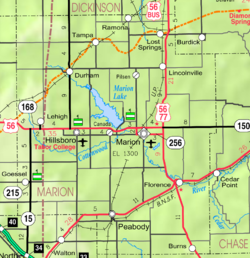Gnadenauwas acommunal villageofGerman-speakingMennonite immigrants from RussiainMarion County, Kansas,United States.[1]It is currently aghost townthat was located approximately 2 miles (3.2 km) southeast ofHillsboro.No buildings remain at this former community site. The Gnadenau Cemetery still exists.
Gnadenau, Kansas | |
|---|---|
 | |
 | |
| Coordinates:38°19′34.413″N97°10′49.882″W/ 38.32622583°N 97.18052278°W[1] | |
| Country | United States |
| State | Kansas |
| County | Marion |
| Township | Liberty |
| Founded | 1874 |
| Elevation | 1,378 ft (420 m) |
| Population | |
• Total | 0 |
| Time zone | UTC-6(CST) |
| • Summer (DST) | UTC-5(CDT) |
| Area code | 620 |
| GNIS ID | 477356[1] |
History
editEarly history
editFor manymillennia,theGreat PlainsofNorth Americawas inhabited bynomadicNative Americans.From the 16th century to 18th century, theKingdom of Franceclaimed ownership of large parts ofNorth America.In 1762, after theFrench and Indian War,France secretly cededNew FrancetoSpain,per theTreaty of Fontainebleau.
19th century
editIn 1802, Spain returned most of the land to France. In 1803, most of the land formodern day Kansaswas acquired by the United States from France as part of the 828,000 square mileLouisiana Purchasefor 2.83centsperacre.
In 1854, theKansas Territorywas organized, then in 1861Kansasbecame the 34thU.S. state.In 1855,Marion Countywas established within theKansas Territory,which included the land for modern day Gnadenau.[2]
In 1874, the German-speaking Mennonites of the Krimmer Mennonite Brethren of Annefeld nearSimferopol,Crimea,Russiadecided to relocate in the United States because Russia removed theirexemption from military service.In August, the group arrived at the site and named itGnadenau,meaningMeadow of GraceorGrace Meadow.[3][4]Unlike the majority ofMennonites,this body adoptedtrine forward immersionas the mode ofbaptism.[5][6]
In 1879, the beginning of the demise of the village occurred when theMarion and McPherson Railway Companybuilt a railway north of village and established the nearby town of Hillsboro.
21st century
editCurrently no buildings exist in Gnadenau, thus it's considered a ghost town. A Gnadenau Village Memorial monument still exists.
Geography
editGnadenau was located at38°19′34.413″N97°10′49.882″W/ 38.32622583°N 97.18052278°W(38.326226, -97.180523),[1]along 175th Street between Jade Road and Kanza Road inMarion County, Kansas.Most residents lived on the north side of 175th Street. A descriptive monument for the Gnadenau Village currently stands on the south side of 175th Street,[7]and the Gnadenau Cemetery is immediately south of it.[1]
Area attractions
editSee also
editReferences
edit- ^abcdef"Gnadenau, Kansas",Geographic Names Information System,United States Geological Survey,United States Department of the Interior
- ^"The History of Marion County and Courthouse".Archived fromthe originalon February 27, 2018.RetrievedApril 23,2014.
- ^Settlement of the Krimmer Mennonite Brethren at Gnadenau, Marion County;Alberta Pantle; Kansas Historical Quarterly; Vol. 13, No. 5; pages 259-285; February 1945.
- ^Settlement of the Krimmer Mennonite Brethren at Gnadenau, Marion County;Alberta Pantle; Kansas Historical Quarterly; Vol. 13, No. 5; February 1945; p259-285.
- ^Krimmer Mennonite Brethren, Global Anabaptist Mennonite Encyclopedia Online.
- ^Gnadenau Krimmer Mennonite Brethren Church, Global Anabaptist Mennonite Encyclopedia Online.
- ^"Gnadenau Village Memorial; Donald I. Good".Archived fromthe originalon October 20, 2013.RetrievedJune 10,2013.
- ^"Mennonite Settlement Museums".Archived fromthe originalon December 12, 2012.RetrievedJune 10,2013.
- ^"Mennonite Settlement Museum".Archived fromthe originalon August 27, 2011.RetrievedJune 10,2013.
Further reading
edit- Grace Meadow: The Story of Gnadenau and Its First Elder, Marion County, Kansas,David V Wiebe; Mennonite Brethren Publishing House; 1967.
- They Seek a Country: A Survey of Mennonite Migrations With Special Reference to Kansas and Gnadenau;David V. Wiebe; Mennonite Brethren Publ. House; 1959.
- Settlement of the Krimmer Mennonite Brethren at Gnadenau, Marion County;Alberta Pantle; Kansas Historical Quarterly; Vol. 13, No. 5; pages 259–285; February 1945.
- The Disciples of Menno Simonis: Their Settlement in Central Kansas;Frank Leslie's Illustrirte Zeitung; March 20, 1875. (German version of English article)
- The Disciples of Menno Simonis: Their Settlement in Central Kansas;Frank Leslie's Illustrated;March 20, 1875. (English)
- Among the Mennonites, Their Houses and Habits - A Visit to Gnadenau.;Johnny Groat; Marion County Record; January 16, 1875.
External links
edit- Historical
- Photos of Gnadenau Village monumentsArchived2013-10-20 at theWayback Machine
- Marion County cemetery list,archive of KsGenWeb
- Marion County history bibliography,Marion County school bibliography,Kansas Historical Society
- Maps
- Marion County maps:Current,Historic,KDOT
- Topo Map of Hillsboro area,USGS

